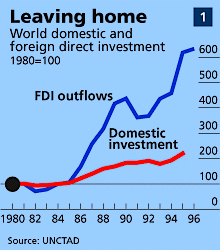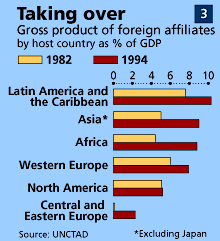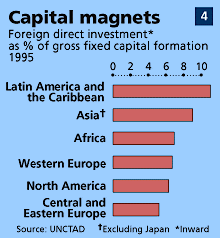|

Scale and scope

In the public mind, globalisation and multinational corporations are closely related. The stereotype has giant companies shifting production from one country to another in search of the cheapest sources of labour, without regard for the well-being of either the high-wage workers who stand to lose their jobs or the low-paid ones who will be hired. Yet globalisation could just as easily make multinational companies less necessary.

Why? As transport costs and trade barriers fall, it becomes easier to serve foreign markets by exporting, rather than establishing factories and research centres around the world. And as capital markets become more integrated and liquid, it is easier for single-country firms to raise money by selling bonds or shares. Big American, Japanese or European firms, which have benefited from their ready access to capital, should therefore be losing one of their main advantages.

This suggests that the economic logic of the multinational company lies elsewhere. Some explanations appear more valid than others, but none fully clarifies why multinationals have become so prominent at the end of the 20th century.

The most common explanation for multinationals’ growth is economies of scale. In certain industries, the argument goes, firms can become more efficient by becoming bigger and producing more. What better way to accomplish this than by serving a global market?

Upon further inspection, however, the notion that economies of scale force companies to become multinationals does not hold up. Consider aircraft manufacturing, an industry in which a big producer has enormous cost advantages over a small one. This industry is dominated by two firms, Boeing and Airbus Industrie. Boeing assembles almost all of its aircraft in the United States, although it buys components from subcontractors around the world. Airbus, which is made up of four separate firms in four different European countries, manufactures only in those countries and relies on exports to sell its aircraft elsewhere. The mere existence of significant scale economies has not forced either to become a true multinational.

Firms may, however, find economies of scale at a level other than that of the factory floor. Coca-Cola is a case in point. Scale is not a huge advantage on the manufacturing side of its business, which involves blending water, gas and a special syrup. Scale economies come into play in other areas, such as reinforcing its brand by making a global marketing effort and helping its bottlers, most of whom are independent, learn from the experiences of their counterparts in other countries. These scale effects have driven Coca-Cola to become a highly multinational company.

Another explanation for the growth in multinationalism is vertical integration. In some industries, the interdependence of suppliers and users of a particular resource makes it difficult for such firms to co-operate at arm’s length, since there is always the risk that one will try to undermine the other. This is the reason many firms integrate vertically, buying up their suppliers or their customers. Sometimes, those suppliers or customers will be abroad, turning the acquiring firms into a multinational.

A third reason for the spread of multinationals is that they tend to be successful. In any business, inefficient firms will eventually fold, giving way to those that can earn higher profits. As the world economy becomes more integrated, it is to be expected that the companies most adept at crossing borders are those that prosper. It should come as no surprise that firms from richer countries do this best. As a rule, they have been exposed to more competition in their home markets and are therefore well equipped for international competitive battles.

There is yet one other reason for firms to operate as multinationals: because everyone else is doing it. Many companies exist to serve other companies, rather than household consumers. If multinational car manufacturers want to use the same headlights in cars assembled in different countries, then headlight manufacturers must become multinational, too. This is why consulting firms and accountancies have been falling over one another to build seamless global networks. Although deregulation and privatisation have had a big effect on the telecoms industry, the demands of corporate customers are helping propel the globalisation of that industry.

Credit the critics

The reasoning above suggests that the growth of multinational companies is fairly benign. But that is not always the case.

For one thing, multinationals’ size and scale can make it possible for them to exert power in an exploitative way. A company whose facilities are located in a single country has no alternative but to comply with that country’s laws and social norms, unless it wishes to import products made by others rather than making them itself. A multinational, however, can move production: if America’s worker-safety law is too restrictive, the company can move its factory to Mexico. It can also lower its tax bill by using internal pricing to shift profits from high-tax countries to low-tax ones.

This flexibility may make it harder for governments to raise revenue, protect the environment and promote worker safety. Critics fear an undesirable “race to the bottom”, with governments reducing desirable social protections to attract investment by multinationals.

Others point out that the race can be healthy insofar as it forces governments to be careful before imposing costly regulations and taxes. Certainly, many developing countries are eager to be “exploited” by as many multinationals as possible.

Another common criticism is that multinationals are exporting jobs to low-wage countries. This may be true in some industries, such as textiles and electronics. But in most cases it is exaggerated. Labour costs now make up only 5-10% of production costs in OECD countries, down from 25% in the 1970s. Multinationals tend to be motivated more by the other considerations that have been mentioned, rather than simple wage-cutting exercises.

Although the social impacts are often misstated, some multinational expansions are indeed unequivocally bad, with no offsetting benefits. Since most company bosses gain esteem (and, studies show, more pay) from operating a bigger outfit, it is no surprise that they expand at every opportunity, whether it is through a merger or a direct foray into a new market. As globalisation takes hold, these adventures are increasingly of a multinational nature. In some cases they represent a wasteful use of shareholders’ capital.

Today, as for many years, roughly three-fifths of all foreign direct investment goes into wealthy countries and two-fifths into “developing” countries. Those two fifths, however, are not flowing into the same countries; China, now the leading recipient of foreign investment among developing countries, received almost none in the 1980s.


In those days, a large share of direct investment in developing countries went into the extraction of natural resources, especially oil, for shipment abroad. Now, however, a much bigger share of it aims to tap local markets. As they become wealthier, people are able to buy more cars, computers and other consumer products. This is why car makers are racing to build plants in countries such as Thailand and Brazil: not to export to Japan and America, but to meet rising demand within South-East Asia and South America. Multinationals are more prominent in these developing economies than in richer ones (see chart 3).

The flows to developing countries, therefore, are going directly to regions with the highest growth prospects (see chart 4). Last year Asia, excluding Japan, captured $80 billion, around two-thirds of the developing-country total; Latin America pulled in another $39 billion. In Eastern Europe, which enjoyed huge inflows in 1994-95, the tap was suddenly shut off last year, as governments sold fewer state-owned companies. Africa, despite its rich natural resources, receives almost no foreign direct investment, because few in the region can afford rich-world consumer products.


Size isn’t everything

Around half of all foreign direct investment involves mergers and acquisitions. These deals help companies to achieve economies of scale in marketing and distribution, for example, and they allow well-managed firms to take over poorly managed ones. Many of those mergers have also been between firms which supply other multinationals with professional services, telecommunications and air travel, in an effort to develop global networks. For all of these reasons, such cross-border M&A activity occurs disproportionately among firms based in rich countries. This is why, for all the interest in developing countries, the United States was the world’s biggest recipient of foreign direct investment last year.

In certain industries and for certain products, the importance of multinational companies is increasing quickly. But the trend is easy to overstate. Most economic activity—cutting hair, driving taxi cabs, renovating houses—is still performed on a small scale. Most industries operate, if not at the level of the town or neighbourhood, then on a national basis. Even in manufacturing, speed, innovation and proximity to customers can matter more than sheer size. Being multinational is no guarantee of success.

© Copyright
1997
The Economist Newspaper Limited.
All Rights Reserved

|




